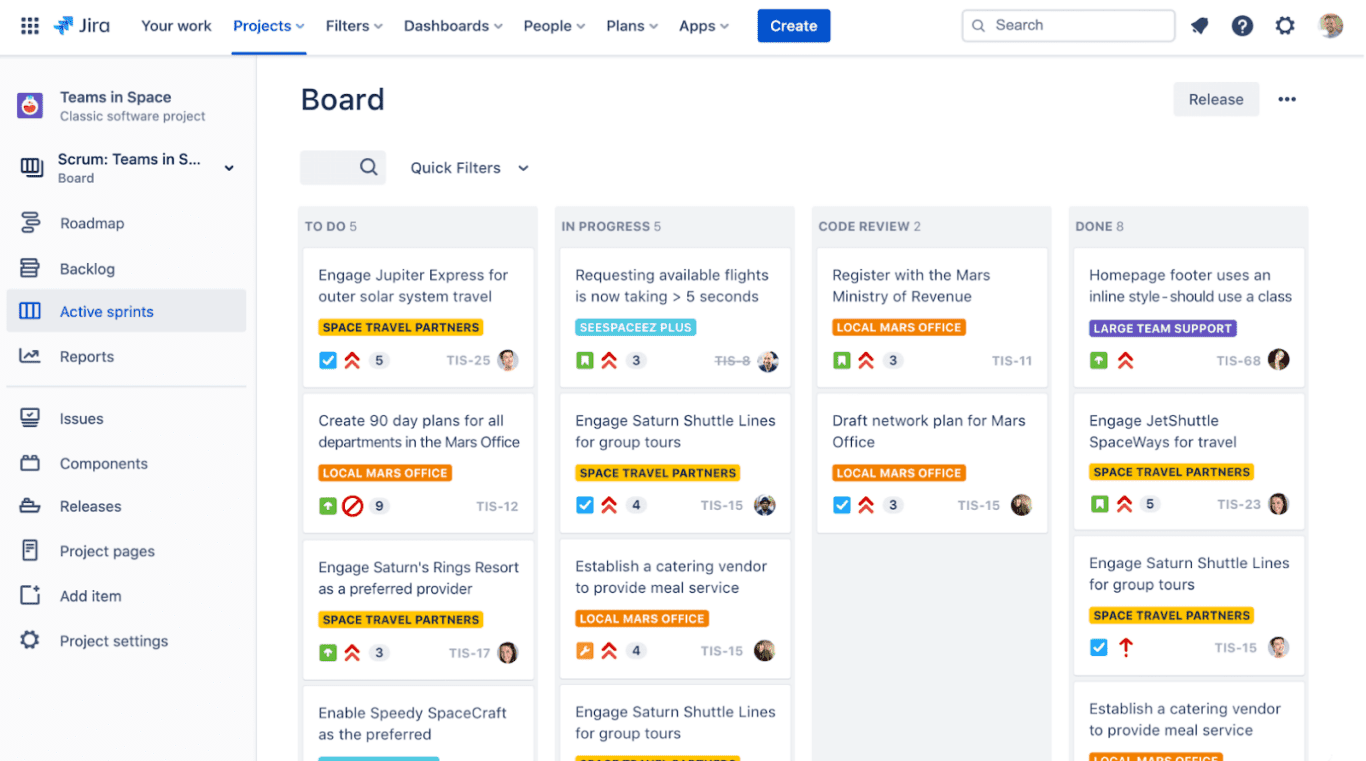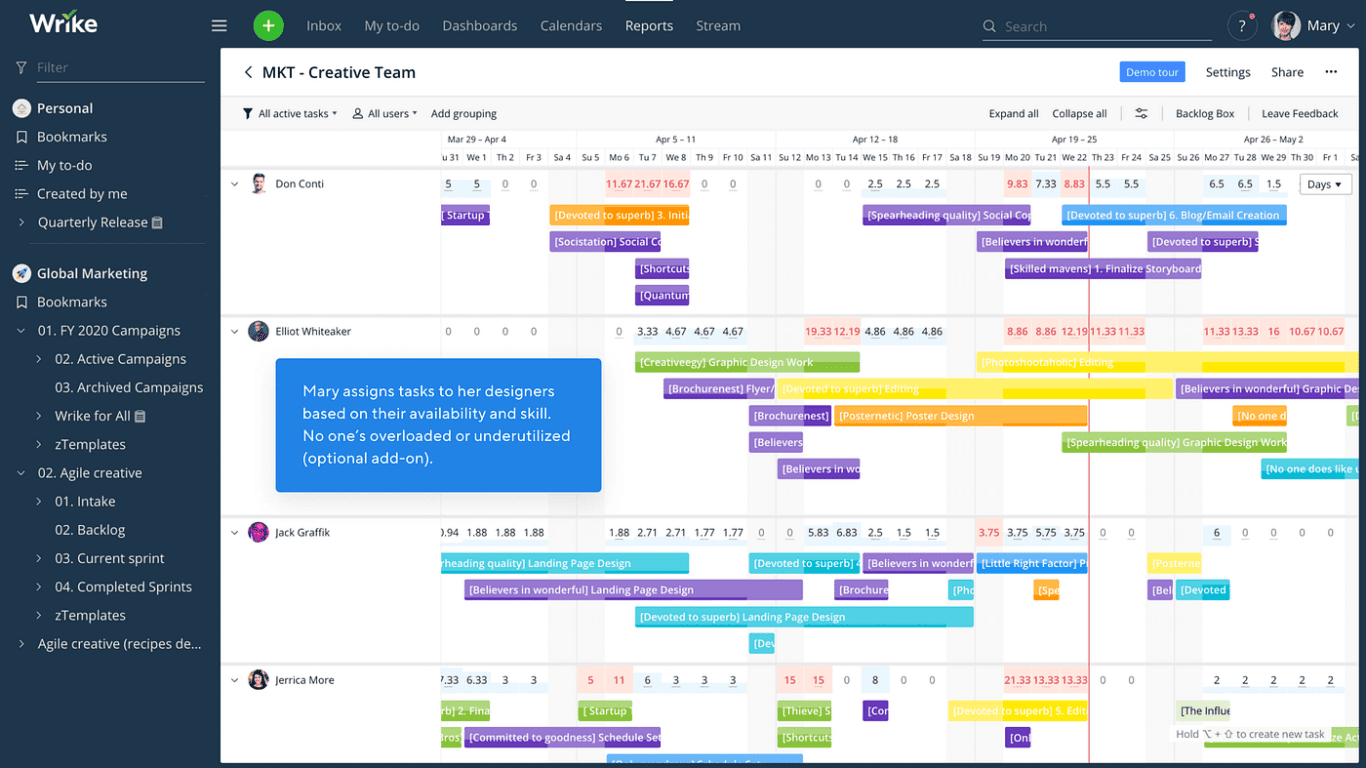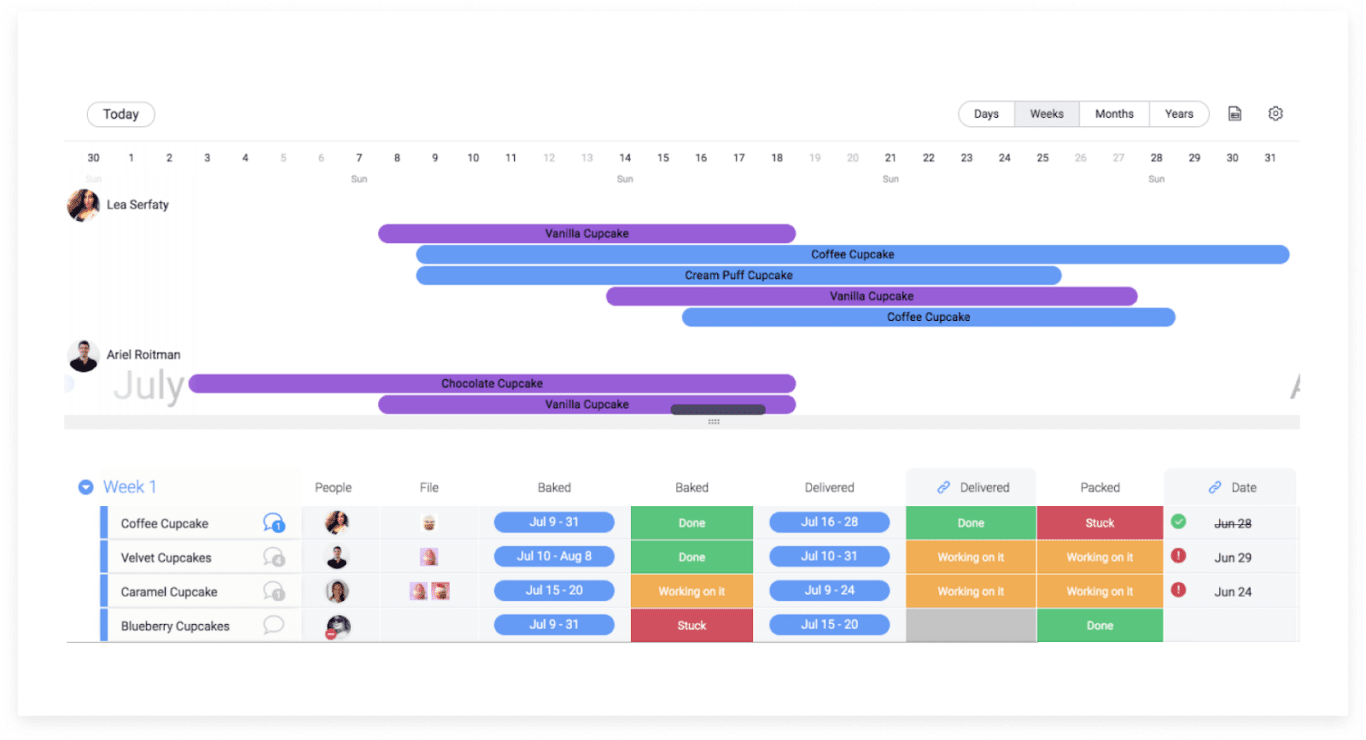The Top 8 Asana Alternatives
Does the word asana make you think about downward dog and lotus pose?
If you’re a project manager, Asana probably makes you think about a different kind of agility. Asana is an extremely popular tool for task management, team collaboration, and project management — so popular, in fact, that it’s practically inescapable.
Asana is a productivity powerhouse, well-loved for its customizability, collaborative potential, and many integrations. But it’s not the only project management tool out there, and it might not be the best option for you.
Here are some of the best Asana alternatives on the market. Whether you’re a seasoned pro or a newbie, you might just find your new project management must-have.
Trello: Best Asana alternative for Kanban

If you’ve worked on any kind of collaborative project, you’ve likely used Atlassian’s project management app Trello already. This board-based tool is one of the most popular Asana alternatives out there.
Features
This project management tool uses the Kanban style of project management. For each project, you’ll create a board, then add multiple lists of tasks, displayed in the system as ‘cards.’ The classic Kanban way to structure a project in Trello would be a board with three lists: To Do, Doing, and Done.
As you work on each task, you can comment on or attach files to its card, then drag it forward to the appropriate list as you make progress. If you want to, you can get more customized than that—but a big part of Trello’s draw is its simplicity!
Trello also offers iOS and Android mobile apps, a powerful search function, and card creation and commenting by email.
Biggest Drawbacks
Trello works best if you’re a small- to medium-sized team managing a relatively simple project. Yes, there’s less functionality than Asana but, depending on your needs, that might be a pro rather than a con.
If your project is complex, or technical, or needs advanced budgeting and dependencies, Trello is probably not the project management tool for you. Trello also doesn’t offer Gantt charts, so if that’s how you visualize your work, you’ll want to look elsewhere.
Pricing
Trello’s free plan is pretty solid. You can add as many users as you like and create up to 10 boards, each with unlimited lists, cards, checklists, and attachments. While you do get unlimited storage, each file can only be as large as 10MB.
If you need more storage or functionality, they have three paid plans: Standard, Premium, and Enterprise. These range from $5 to $17.50 monthly, per user.
Jira: Best Asana alternative for software development

Jira is a super-powerful, fairly technical project management tool. Like Trello, it’s an Atlassian product, but it’s designed for maximum capability and agile project management, rather than ease of use.
Features
Jira is ideal for DevOps, since it was originally designed for bug tracking in software development. Jira is very flexible — it can handle the Lean, Kanban, and Scrum styles of project management. It’s also designed to play well with your other tools, offering over 3000 integrations.
Jira also offers strong security, great reporting capabilities, and customizable dashboards. Unlike Trello, it provides roadmapping, dependency management, and capacity planning (in the more expensive paid versions, anyway). But like Trello, you can access Jira from mobile iOS and Android apps.
Biggest Drawbacks
Don’t choose Jira unless you actually need an Asana alternative with all these advanced features. It can have a bit of a steep learning curve for less technical users.
If you aren’t working on a software project involving lots of bug-tracking or issue-tracking, getting comfortable with Jira will likely be more trouble than it’s worth. It’s also pricey. But if you need that robust suite of features, that could be a justifiable expense.
Pricing
Jira’s free plan is intended for small teams, allowing up to 10 users access to most of its capabilities.
The Standard plan costs $7.75 per user monthly and allows up to 20,000 users, with similar functionality as the free plan.
The Premium ($15.25/user per month) and Enterprise (contact for pricing) plans offer more advanced capabilities around capacity planning, automation, support and storage.
Whatever plan you choose, you can test out a free trial before you commit.
Already using Jira and Asana and don’t want to switch? Here’s how you can keep both tools in sync with Unito.
ProofHub: Best Asana alternative for project management And team collaboration

ProofHub is an all-in-one project management and team collaboration software that comes loaded with robust features. The platform is a one-stop solution for all your project management needs, eliminating the hassle of juggling multiple apps.
Features:
ProofHub has a user-friendly and simplified user interface, which everyone struggling with Asana would love to have. Apart from its multiple task views and file-sharing capabilities, you can customize the platform to your business-specific needs.
With ProofHub’s custom reports, you can get insights into a project and team’s progress and performance, spot bottlenecks, and identify opportunities for improvement in no time. Also, you get built-in chat and discussions to stay connected with your team members in real-time. You can attach files, add comments, and mention team members right on the tasks to make collaboration seamless.
One thing that you will surely like the most is its online proofing tool. You can use this to review, approve, and share actionable feedback on files directly.
Biggest Drawbacks
ProofHub is a comprehensive software that is not suitable for solopreneurs or individuals.
Apart from that, its limited integration is a minor problem as of now, which they are planning to upgrade shortly.
Pricing:
ProofHub offers two most straightforward flat-fee, no-per-user pricing plans – without hidden fees or surprise charges.
With ProofHub’s Essential plan, starting at a flat $45/month (when billed annually), you get unlimited projects, tasks, and users. On the contrary, for Asana’s Starter plan, you must pay $109.9/month for 10 users for the same features.
For more advanced features and functionalities like workflows, custom roles, and priority support, you may want to upgrade to ProofHub’s Ultimate Control plan for only a flat $89/month.
You can add as many users as you want to, making its plans highly suitable for teams scaling and growing. And what captures the most attention is that the cost scale doesn’t rise with every onboarding.
Basecamp: Best simple Asana alternative

Basecamp is a simple, yet powerful project management system. Ruled by the almighty checklist, Basecamp is all about getting things done.
Features
Basecamp breaks your projects down into tasks, then ticking them off your list. Under each project, you’ll organize what needs to get done into checklists, which you can comment on, attach files to, and set deadlines for.
Basecamp offers a library of project templates, and you can view tasks in Gantt format if your brain works that way. Thanks to some handy integrations, your team can also track hours directly within the app!
Biggest Drawbacks
As we mentioned, Basecamp is highly list-centric — it’s not nearly as flexible or all-encompassing as Asana. It also doesn’t offer any reporting or budgeting tools.
However, if you live and die by your checklist and you’re looking for a super-simple user experience, Basecamp might be a match made in heaven.
Pricing
Basecamp offers two paid plans, each with a free 30-day trial. Basecamp’s regular plan is $15/user per month, and gives you access to all of Basecamp’s features. The only real limitation is storage, but the plan gives you 500GB, which should be enough for most organizations.
The other plan is Basecamp Pro Unlimited, which gives you unlimited users for $299/month when billed manually, or $349/month when you pay month-to-month. This plan gives 10 times more storage, priority customer support, a personal onboarding with the Basecamp team, and a few more features.
If you have a larger organization, the Pro Unlimited plan is probably best for your needs. But you can easily get started with Basecamp’s regular plan, especially if you don’t have more than 20 users — at which point the flat $299/month becomes more attractive.
Wrike

Wrike is a popular project management tool for businesses of all sizes, and is a one-stop shop for managing tasks across departments, integrating other apps, and streamlining workflows.
Features
Just like Asana, one of Wrike’s strengths is the ability to represent work in a number of different views. If you’re a fan of the Kanban methodology, for example, you could use Wrike to represent every single project as a Kanban board. But you can also use tables, Gantt charts, and even calendars to represent project-essential work.
Wrike also has built-in reports, all of them completely automated. That means you can dynamically pull data from multiple projects and analyze workload, surface overdue tasks, and even adjust resource planning for each project on the fly.
This all makes Wrike one of the most fully-featured Asana alternatives out there, and one of the most similar.
Biggest drawbacks
One of the biggest drawbacks of Asana alternatives like Wrike is the same as what you’ll find with Asana: the steep learning curve. If your team has never used a project management tool before, it might take some time to get them going. That also means that you might have to help them get the most of all Wrike features.
Some users have also said that Wrike should offer more in the way of automations, since they’re incredibly useful but don’t cover every potential project management task a user needs to perform.
Pricing
Wrike has a completely free plan that supports an unlimited number of users, and has the basic task management and project management features you need to get your team started. You won’t have access to custom fields, automated workflows, and Wrike’s more advanced features.
This Asana alternative has two primary paid plans: the Team plan at $9.80 per user, per month, and the Business plan at $24.80 per user, per month. The former can support 2-25 users, while the latter supports 5-200 users. Both plans will give you access to work schedules, custom fields, and workflows, but only the Business plan offers project portfolio management and real-time reports.
Monday.com

Like Basecamp, monday.com is a task-centric tool. But it’s powerful and flexible enough to give Asana a run for its money.
Features
Monday.com is great for teams who need to work on projects together in real time. You can create shared, collaborative files, and they offer advanced communication capabilities. It also offers a healthy amount of integrations, like Dropbox, Zoom, Google Calendar, and Excel.
With plenty of templates, you have lots of options for structuring your project in Monday.com. Then, you can assign tasks to specific users, give them a priority rating, and track their completion.
Biggest Drawbacks
Monday.com is more sophisticated than Basecamp. But it’s still about getting tasks done, rather than understanding projects as a whole.
While it does have multiple ways to view your project, such as Kanban boards, Timelines, or Calendars, they’re all just different ways to display listed tasks. The tool doesn’t have a feature comparable to Asana’s Portfolio, which gives you a big-picture view of multiple related projects.
Monday.com’s reporting capabilities are also limited, and some users find its navigation a little confusing.
Pricing
As Asana alternatives go, Monday.com is on the more expensive side. Its Free plan is designed for individuals, rather than teams, and only allows 2 users. Neither the Free nor Basic plans ($11 monthly per user) offer Automation or Integrations, and you can’t view your project as a Timeline, Gantt Chart, or Calendar.
Their Standard and Pro plans offer more functionality. But at $14 and $22 monthly per user, Monday.com could get expensive, especially if you have a large team.
ClickUp: Best all-in-one Asana alternative

Affordable, flexible, and feature-rich, ClickUp is an increasingly popular alternative to Asana. Here’s what you need to know about this new kid on the project management block.
Features
Like many other project management tools, ClickUp allows you to create checklists, assign tasks, and set dependencies. You view your project in a variety of ways, such as list, board, or grid, and schedule meetings and set reminders within the app.
ClickUp is also known for its integrations, including Dropbox, Toggl, and Google Drive. Because it offers so much functionality, there might be a bit of a learning curve when adapting to ClickUp. But in general, the app’s interface is still modern, intuitive, and clean.
While ClickUp robust project management features, ClickUp really shines in just how much it offers. It’s not just a great tool to track progress and manage projects, it also has a built-in word processor, time-tracking tool, chat tool, and even AI functionality. That makes it your one-stop-shop for all the collaboration features you need, and one of the more fully-featured asana alternatives out there.
Biggest Drawbacks
Overall, ClickUp is a good alternative to Asana. But since it hasn’t been around for as long (it launched in 2016, compared to Asana’s 2008), there are still some kinks in the system that are being ironed out.
You might find the software to be laggy now and then, especially if you have multiple tasks open at once or you’re switching between project views. There are also no built-in automations, although you can still create them through third-party integrations.
Pricing
ClickUp’s free plan offers great value, and their paid options, which range from $5 to $19 monthly per user, aren’t so bad either.
The Free plan allows you to add an unlimited number of users and tasks, while you’ll get unlimited integrations, storage, and dashboards on the cheapest plan — the Unlimited plan at $7 per user, per month. If you ask us, that’s a pretty good deal!
Microsoft Project

Microsoft Project is one of the OG project management tools. It’s been used to handle projects and tasks since 1984, the earliest days of the Internet (although obviously, it’s been updated since then).
Features
Microsoft Project is definitely not the most modern-looking project management tool ever, but it’s more than powerful enough to get the job done. Expect Gantt charts, scheduling and planning tools, resource management, and more. Everything you need to handle even the most complex projects.
If you’re leading a team of Microsoft lovers and looking for an app that plays well in that ecosystem, Microsoft Project might be the perfect Asana alternative for you.
Biggest Drawbacks
As we said, this project management solution is a bit of a throwback. If you’re looking for a slick, modern user experience, you definitely won’t find it here.
It’s also pretty complex. It’s most often used by organizations with a dedicated Project Management Office (PMO), and you’ll probably need a dedicated administrator or project management professional (PMP) to handle it.
Pricing
Microsoft Project offers both cloud-based and on-premise solutions. Cloud options range from $10.00 to $55/user per month, while the on-premise desktop app has two pricing tiers, $679.99 and $1,129.99 (each per user, per month).
Dedicated project servers are another option, too — reach out to Microsoft for quotes.
Keep your projects in line with Asana alternatives
In today’s remote-first world, project management tools are more important than ever. When most of your team collaboration happens through a screen, the tools you use to connect are a make-or-break part of your working experience — not to mention your project’s success!
That’s why selecting your project management tool is such a big decision, and why it’s great that you’re considering all your options. No matter which alternative to Asana you pick, we’ve got plenty of project management resources to help you along the way.


